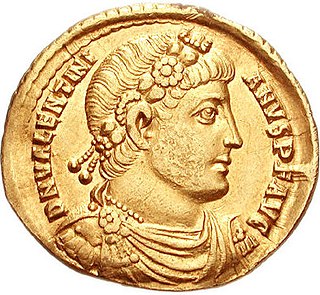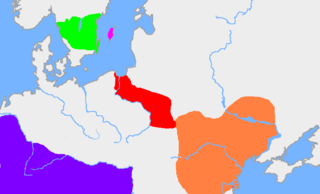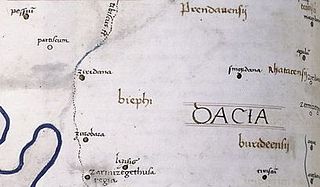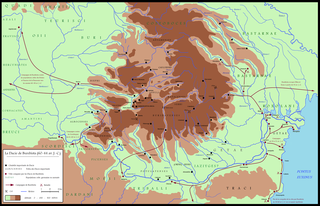Ammianus Marcellinus was a Roman soldier and historian who wrote the penultimate major historical account surviving from antiquity. His work, known as the Res Gestae, chronicled in Latin the history of Rome from the accession of the Emperor Nerva in 96 to the death of Valens at the Battle of Adrianople in 378, although only the sections covering the period 353 to 378 survive.

Valentinian I, sometimes called Valentinian the Great, was Roman emperor from 364 to 375. Upon becoming emperor, he made his brother Valens his co-emperor, giving him rule of the eastern provinces. Valentinian retained the west.

The Sarmatians were a large Iranian confederation that existed in classical antiquity, flourishing from about the fifth century BC to the fourth century AD.

The Roxolani or Rhoxolāni were a Sarmatian people documented between the 2nd century BC and the 4th century AD, first east of the Borysthenes (Dnieper) on the coast of Lake Maeotis, and later near the borders of Roman Dacia and Moesia. They are believed to be an offshoot of the Alans.

The Dacian Draco was the standard ensign of troops of the ancient Dacian people, which can be seen in the hands of the soldiers of Decebalus in several scenes depicted on Trajan's Column in Rome, Italy. This Wind instrument has the form of a dragon with open wolf-like jaws containing several metal tongues. The hollow dragon's head was mounted on a pole with a fabric tube affixed at the rear. In use, the draco was held up into the wind, or above the head of a horseman, where it filled with air and gave the impression it was alive while making a shrill sound as the wind passed through its strips of material.
Alatheus and Saphrax were Greuthungi chieftains who served as co-regents for Vithericus, son and heir of the Gothic king Vithimiris.

The Costoboci were an ancient people located, during the Roman imperial era, between the Carpathian Mountains and the river Dniester. During the Marcomannic Wars the Costoboci invaded the Roman empire in AD 170 or 171, pillaging its Balkan provinces as far as central Greece, until they were driven out by the Romans. Shortly afterwards, the Costoboci's territory was invaded and occupied by Vandal Hasdingi and the Costoboci disappeared from surviving historical sources, except for a mention by the late Roman Ammianus Marcellinus, writing around AD 400.

The Siege of Amida was a military investment of the Roman fortified frontier city of Amida by the Sasanian Empire. It took place in AD 359 when the Sasanian army under king Shapur II invaded the eastern provinces of the Roman Empire. Shapur wanted to exploit the absence of the Roman Emperor Constantius II who was overseeing affairs in the western part of the Empire. The city fell, but the strategic gain was little.
Thracology is the scientific study of Ancient Thrace and Thracian antiquities and is a regional and thematic branch of the larger disciplines of ancient history and archaeology. A practitioner of the discipline is a Thracologist. Thracology investigates the range of ancient Thracian culture from 1000 BC up to the end of Roman rule in the 4th–7th centuries AD. Modern Thracology started with the work of Wilhelm Tomaschek in the late 19th century.

The Thervingi, Tervingi, or Teruingi were a Gothic people of the plains north of the Lower Danube and west of the Dniester River in the 3rd and the 4th centuries.

The Greuthungi were a Gothic people who lived on the Pontic steppe between the Dniester and Don rivers in what is now Ukraine, in the 3rd and the 4th centuries. They had close contacts with the Tervingi, another Gothic people, who lived west of the Dniester River. To the east of the Greuthungi, living near the Don river, were the Alans.

The Taifals or Tayfals were a people group of Germanic or Sarmatian origin, first documented north of the lower Danube in the mid third century AD. They experienced an unsettled and fragmented history, for the most part in association with various Gothic peoples, and alternately fighting against or for the Romans. In the late fourth century some Taifali were settled within the Roman Empire, notably in western Gaul in the modern province of Poitou. They subsequently supplied mounted units to the Roman army and continued to be a significant source of cavalry for early Merovingian armies. By the sixth century their region of western Gaul had acquired a distinct identity as Thifalia.
Vidigoia was a Thervingian Gothic warrior. His name means either "the man from the forest zone" or "the forest-barker/wolf".
The Victohali were a people of Late Antiquity who lived north of the Lower Danube. In Greek their name is Biktoa or Biktoloi. They were possibly a Germanic people, and it has been suggested that they were one of the tribes of the Vandals.

Zurobara was a Dacian town located in today's Banat region in Romania. It is positioned by the Tibiscus river, north of Zarmizegethusa Regia and south of Ziridava. It was near the Tisza river, in the area of the Dacian tribe of Biephi.

Dava was a Geto-Dacian name for a city, town or fortress. Generally, the name indicated a tribal center or an important settlement, usually fortified. Some of the Dacian settlements and the fortresses employed the Murus Dacicus traditional construction technique.
The Limigantes is a name applied to a population that lived by the Tisza river, in Banat, in the 4th century. They are attested by Roman historian Ammianus Marcellinus in connection to Sarmatians.

Athanaric or Atanaric was king of several branches of the Thervingian Goths for at least two decades in the 4th century. Throughout his reign, Athanaric was faced with invasions by the Roman Empire, the Huns and a civil war with Christian rebels. He is considered the first king of the Visigoths, who later settled in Iberia, where they founded the Visigothic Kingdom.
Montes Serrorum is a mountain somewhere in the Carpathians mentioned by Roman soldier Ammianus Marcellinus (325–391) regarding events in the Gothic War (367–369).










